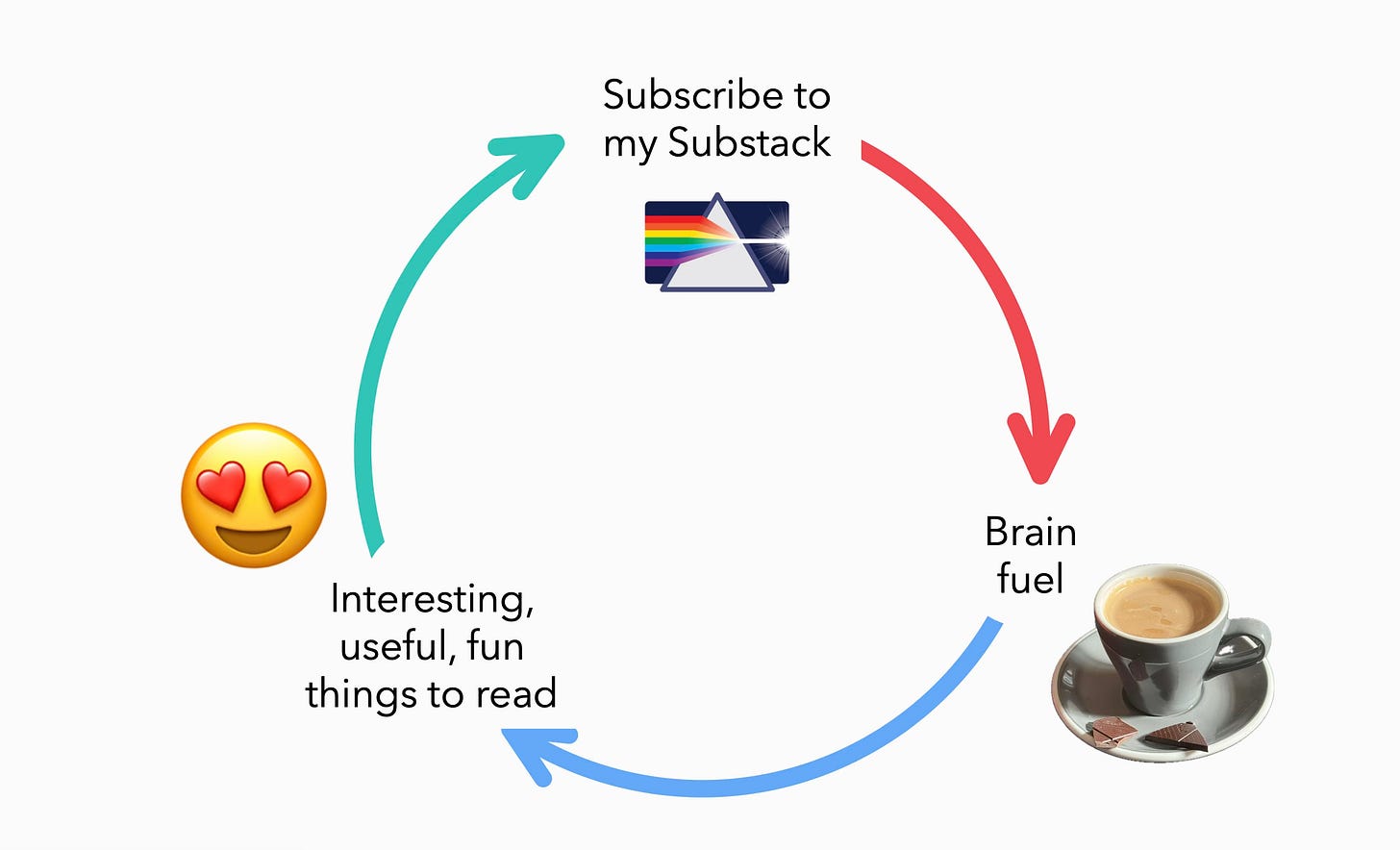My writing process
How these articles come to be, and some recommendations about other Substackers to follow.
Someone recently asked me how I manage to write a Substack article every week while still apparently keeping up with work and life. Surprisingly (to me as well) it’s not that hard. I thought it might be worth sharing... hope you agree. Does any of the following sound like your writing process too?
Sources of ideas
I’ve always got half a neuron looking out for potential Evaluation and Value for Investment topics. There are more ideas in the world than I can ever write about and the biggest challenge is choosing. Sources of inspiration include aspects of projects I'm involved in, comments or questions from workshop participants, news articles that intersect with my interests, and building on other people’s ideas. I’m also gradually checking off a list of topics I mean to cover in an eventual book, which guides some of my content creation and should possibly guide it more. I’m happy to receive requests too…!
Writing on the go
I mostly write drafts on my phone.1 It’s always there so I can jot down an idea any time it occurs to me. Each draft starts out as a brain dump of fragments, about a third to a half of which later get developed or combined into articles. As time permits, I flesh out a paragraph or two - often during ‘quiet’ moments like sitting in trains, planes and cafes. I find the creative process more stimulating than scrolling social media or playing games.
If I’m adapting an idea from my academic writing, published consulting reports or presentations, it’s usually a fairly quick process to translate something I’ve already thought hard about into blog language. Other times I’m developing something new, which can take a lot longer, sometimes pausing the work for weeks before picking it up again.
Do I get AI to help? Sometimes. Mainly to help with background work like topic scoping or literature searches, but not to write for me (unless my post is directly reproducing a conversation I’ve had with ChatGPT or Perplexity). Doing the writing myself is an important part of the thinking process. I also prefer the quirks of my own penmanship over the predictable banality of AI-speak - even if, as said one friend, like the scribings of Yoda my writing sometimes is.
Editing and review
Once a week, I choose a half-done article out of my drafts folder, finish it off and do the final edit on my computer. It’s more efficient to add links, pictures, and proofread on a big screen with a real keyboard.
I often ask a colleague to review a draft, which always adds valuable perspective. A few times I’ve twisted somebody’s arm to co-author which adds new dimensions to the writing. I’d like to do more of that in the future.
After a final edit, I read it one.. more… time, …hold my breath, and hit send. Emailing 800 (and growing) discerning readers with one click can feel a little bit scary and I take my time over it.
Consistency and impact
For the last year and a half, I've found it quite feasible to keep up a consistent pace of one article each week. I get intrinsic satisfaction from the writing process. It also helps me clarify thoughts on topics and tools that I later include in workshops, presentations and evaluation projects. Beyond the innate value of the writing process, publishing on Substack has also led to new connections, collaborations, and speaking engagements.
I’m always happy to receive feedback on whether the articles have met my aims of being interesting, useful, and fun. As to impact, tell me: Have my posts helped you tackle real-world evaluation challenges or view something from a new perspective? Am I disrupting value-for-money assessment? Constructive comments and questions are always welcome - it’s how we grow.
I’m also a Substack reader
Substack is social media for grownups, a positive place to share ideas and help each other figure things out. We’re all teachers and learners here! Other evaluators (and evaluation-adjacent folks) I follow include:
Aden Date - Measuring the Immeasurable - a kindred spirit writing about the evaluation of culture and the culture of evaluation
Andrew Hollo - Weekly 5 Minute Strategic Mindset - a rich diversity of interesting insights, always a good ROI on my 5 mins
Anna McMartin - The End is Naenae - wonderfully incisive takes on NZ life
Cameron Norman - The Design Loft, Censemaking Innovation, and The Innovator’s Dilemmas - writing about innovation and change by design
Dave Heatley & colleagues - Asymmetric Information - interesting essays on economic topics
Jonathan Glennie & colleagues - Global Nation - must-read insights into ways forward for international development
Roger Pielke Jr - The Honest Broker - a courageous evaluative thinker making sense of science, policy and politics
W. Gyude Moore - The Africa Project - astute essays on Africa’s policy landscape with a view to an Africa that thrives economically, socially and culturally.
Who else is good to follow? I welcome your recommendations.
Your turn?
My writing process is a cycle of idea generation, short bursts of thumb-drafting, focused editing, review and publishing. It's turned out to be a process that not only produces (hopefully) some worthwhile content but is intrinsically valuable and contributes to my own professional development and relationships.
I invite you to join me on this mostly uncharted expedition by subscribing, engaging (comment, share, leave a ❤️ so I know if you like it), and using your Substack account to blog about something you’re into. If you’re already writing on Substack, share something about it in the comments!
New contents page
I’ve revamped my contents page to make it easier to find articles from the archive. It’s organised thematically. Let me know what you think.
After Apple’s AI announcement,



